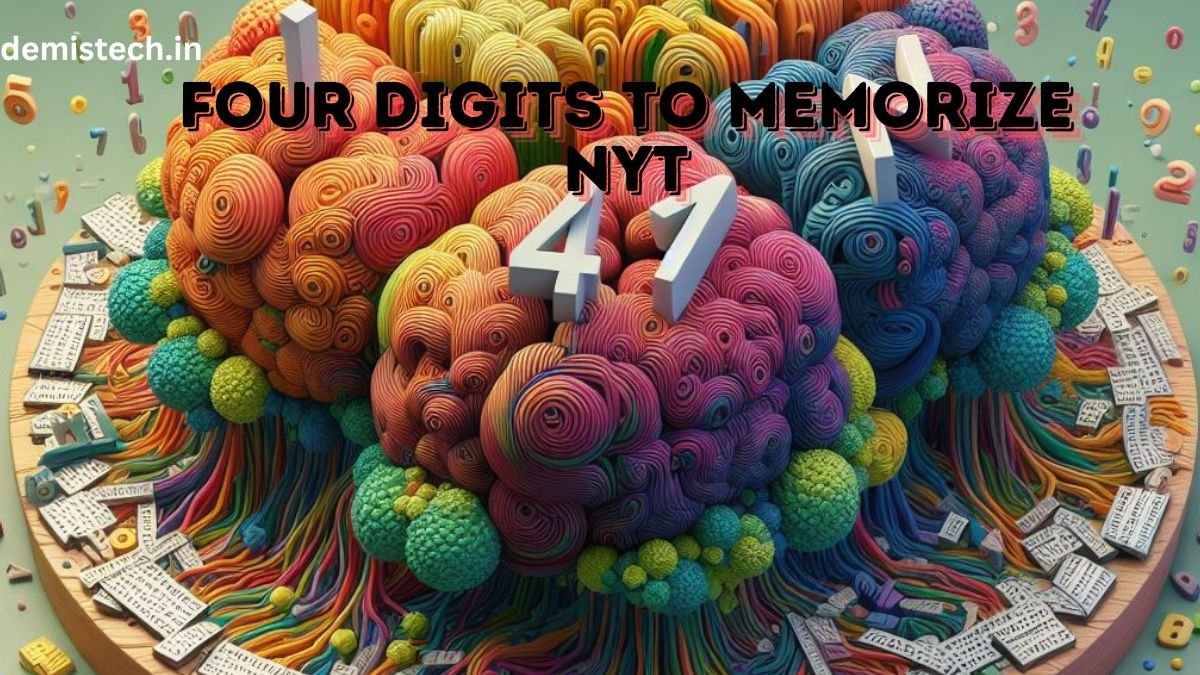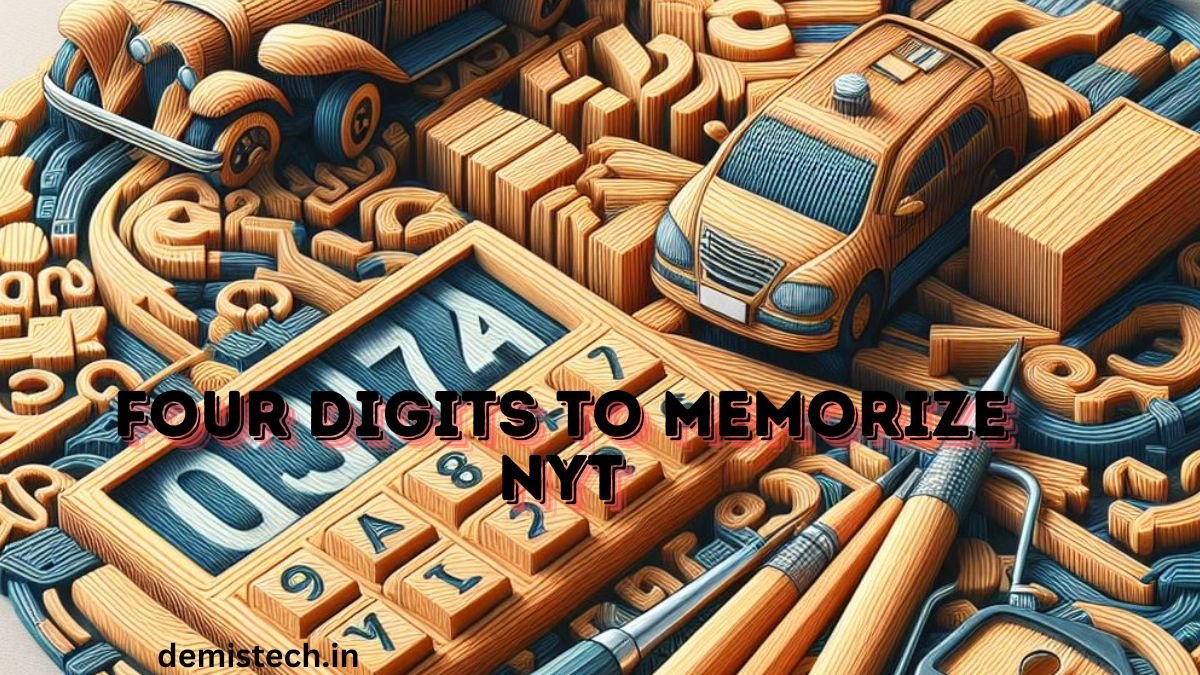Four digits to memorize nyt have always fascinated us, testing our minds and offering a delightful break from our daily routines. Among these, the four-digit puzzle challenge has garnered significant attention, especially through platforms like the New York Times (NYT). Let’s dive into what makes these puzzles so captivating and how you can master them.
What Are “Four digits to memorize nyt”?
The “Four Digits to Memorize” puzzles are a popular brain teaser featured by the New York Times. These puzzles require participants to remember and manipulate a series of four-digit numbers to reach a solution. They are fun and intellectually stimulating, pushing the boundaries of our cognitive abilities.
Overview of the NYT Puzzle Culture
The New York Times is renowned for its extensive collection of puzzles, from crosswords to Sudoku. The introduction of four-digit puzzles adds to this rich tradition, drawing puzzle enthusiasts from around the globe. This culture of puzzling fosters a community where solvers share tips, strategies, and even their personal successes.
The Appeal of the Four-Digit Challenge
Why People Love Brain Teasers
Brain teasers offer a perfect blend of challenge and entertainment. They are a great way to keep the mind sharp and engaged, offering a sense of accomplishment once solved. The four-digit puzzles, in particular, are addictive because they seem deceptively simple yet require deep thinking.

The Popularity of Numerical Puzzles
Numerical puzzles, like the four-digit challenges, have surged in popularity because they cater to our inherent love for numbers and logic. They are universally understood and provide a clear, objective goal that can be deeply satisfying to achieve.
How the Four-Digit Puzzle Works
Basic Rules
The rules of the four-digit puzzle are straightforward. You are presented with a series of four-digit numbers, and you must either rearrange or use them in specific operations to achieve a target outcome. The simplicity of the rules is part of the allure, making it accessible to a wide audience.
Examples and Scenarios
For instance, you might be given the numbers 1234, 5678, 9101, and 1121, and need to find a way to combine them using addition, subtraction, multiplication, or division to reach a specific number, say 10000. Each puzzle varies in complexity, offering new challenges with each iteration.
Strategies for Solving Four-Digit Puzzles
One of the key strategies is to look for patterns in the numbers. This could be sequences, repetitions, or familiar numerical relationships that can simplify the solving process.
Elimination Method
By systematically eliminating possibilities that don’t fit the criteria, you can narrow down the potential solutions. This method is particularly useful in more complex puzzles.
Logical Sequencing
Ensuring that each step logically follows the previous one is crucial. This involves careful planning and considering the consequences of each action before making a move.
Benefits of Engaging with Numerical Puzzles
Cognitive Development
Regularly engaging with numerical puzzles enhances cognitive functions such as memory, concentration, and logical thinking. It’s like a workout for your brain.
Stress Relief: Solving puzzles can be a meditative activity, helping to reduce stress and anxiety. The focus required diverts your mind from daily worries, providing a mental escape.
Improved Concentration: Puzzles demand undivided attention, which can translate into improved concentration in other areas of life. Over time, this can significantly enhance productivity and efficiency.
Common Mistakes and How to Avoid Them
Overthinking
Sometimes the simplest solution is the correct one. Overcomplicating a puzzle can lead to frustration and mistakes. Try to approach each problem with a clear and straightforward mindset.
Ignoring Obvious Patterns
Often, the answer lies in the most obvious pattern or sequence. Ignoring these can lead to unnecessary complications. Always start by examining the simplest patterns first.
Inconsistent Approaches
Having a consistent method for tackling puzzles can improve your success rate. Whether it’s starting with a particular type of operation or checking for certain patterns, consistency is key.
Advanced Techniques for Mastery
Using the memory palace technique, where you visualize placing each number or step in a specific location in an imagined place, can greatly enhance recall and organization.
Mnemonic Devices: Creating mnemonic devices to remember sequences or operations can be very helpful, especially in more complex puzzles where multiple steps are involved.
Cross-Referencing with Other Puzzles
Drawing parallels between different types of puzzles can provide new insights and strategies. Techniques that work in Sudoku or crosswords, for instance, might be adapted to four-digit puzzles.
Integrating Four-Digit Puzzles into Daily Routine
Morning Brain Exercises
Starting your day with a puzzle can set a positive tone and kickstart your brain. It’s a great habit that can lead to improved mental clarity and focus throughout the day.
Puzzle Apps and Online Resources: There are numerous apps and online platforms dedicated to puzzles. These resources can provide a steady stream of new challenges to keep your skills sharp.
Collaborative Solving with Friends and Family: Puzzles don’t have to be a solo activity. Solving them with friends or family can be a fun and bonding experience, fostering teamwork and collective problem-solving.
- Real-Life Applications of Puzzle-Solving Skills: The problem-solving skills honed through puzzles are directly applicable in real-life situations, from work challenges to everyday decision-making.
- Better Decision-Making Skills: The logical thinking and foresight developed through puzzles can improve your ability to make well-informed and strategic decisions.
Application in Professional Settings
Employers often value the critical thinking and analytical skills that puzzle enthusiasts develop. These skills can be a great asset in any professional environment.
The Community Aspect of NYT Puzzles
Joining online forums and groups can provide additional support and inspiration. These communities are great for sharing strategies and celebrating successes.
Competitive Solving
For those who thrive on competition, many platforms offer timed challenges and leaderboards, adding an exciting edge to the puzzle-solving experience.
Sharing Strategies and Tips
Being part of a community means you can learn from others. Sharing your strategies and learning new ones can greatly enhance your skills.
Impact of Regular Puzzle-Solving on Mental Health
Anxiety Reduction
The focus and concentration required for puzzles can help reduce anxiety by providing a distraction from stressors.
Mood Improvement
Successfully solving a puzzle releases dopamine, the feel-good hormone, which can improve your mood and overall mental state.
Overall Mental Wellbeing: Engaging regularly with puzzles can contribute to better mental health, promoting a balanced and healthy mind.
Four-Digit Puzzles as Educational Tools
Teaching Math Skills
Puzzles are a fun and engaging way to teach and reinforce math skills in children, making learning enjoyable.
Encouraging Logical Thinking in Kids
Early exposure to puzzles can foster logical thinking and problem-solving abilities in children, skills that are valuable throughout life.
Classroom Activities and Resources
Teachers can incorporate puzzles into classroom activities to enhance learning and make lessons more interactive and enjoyable.
Origin and Evolution
Number puzzles have a rich history, dating back to ancient times. Understanding their origin can provide deeper appreciation and insight into their development.
Famous Numerical Puzzles in History: Exploring famous numerical puzzles from history can inspire and challenge today’s enthusiasts, connecting them to a long tradition of intellectual pursuit.
Testimonials and Success Stories
Individual Records
Hearing from people who have profited from riddles can spur. Their accounts feature the pragmatic advantages and delight of puzzle-addressing.
Popular Characters Who Appreciate Riddles
Some notable characters are eager riddle solvers. Their encounters can act as motivation and show the wide allure of riddles.
Local area Features
Highlighting individuals from the riddle local area and their accomplishments can cultivate a feeling of having a place and urge others to partake.
Conclusion
The Four digits to memorize nyt from the New York Times offer an engaging, challenging, and beneficial activity for all ages. Whether you’re looking to sharpen your mind, reduce stress, or enjoy a fun pastime, these puzzles are a fantastic choice. Dive into the world of four-digit puzzles and discover the joy of solving them.


